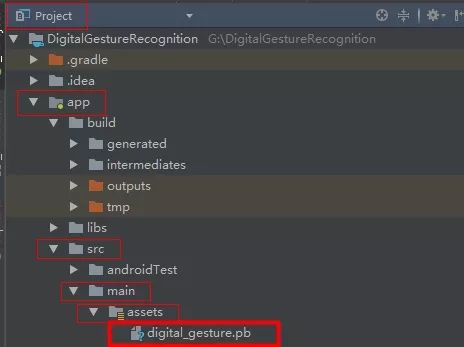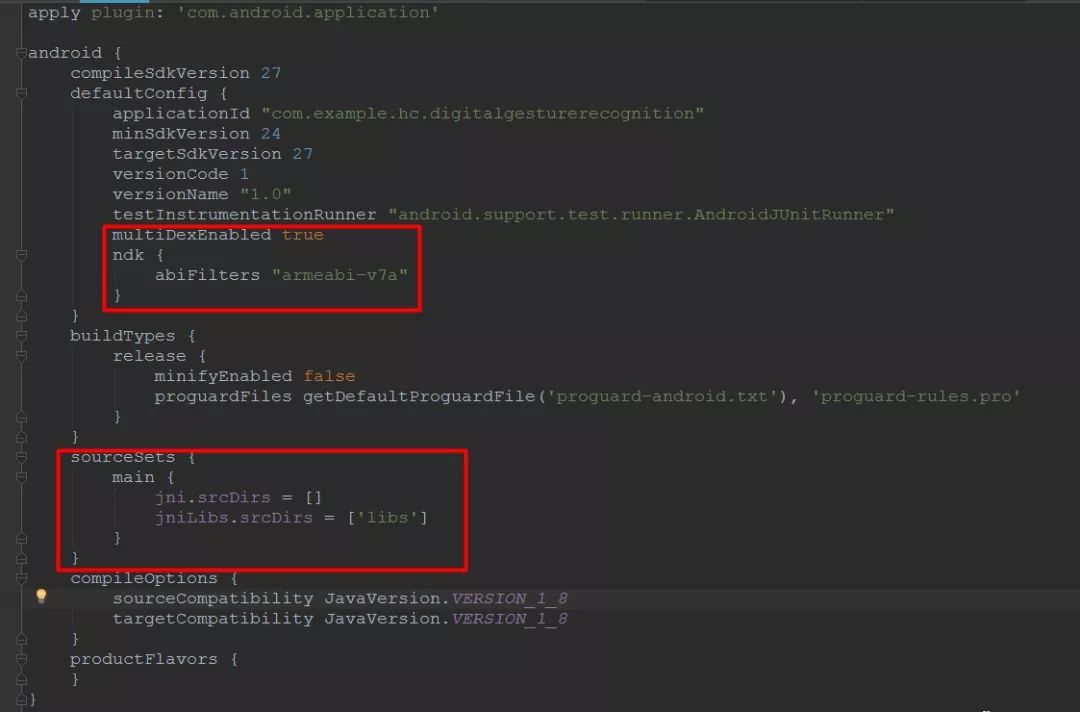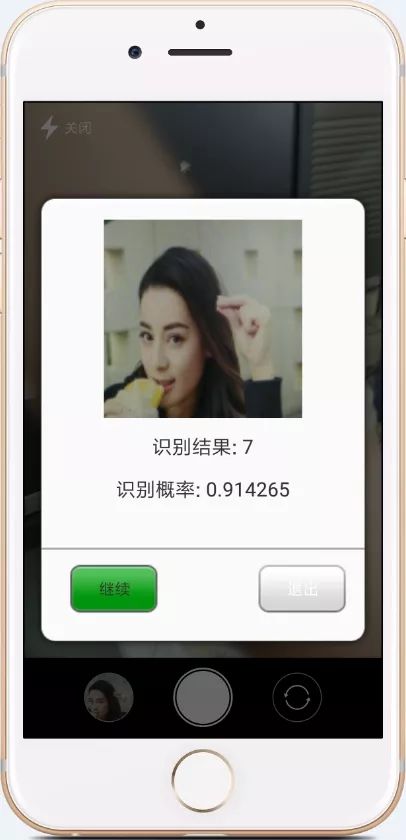将 TensorFlow 训练好的模型迁移到 Android APP上(TensorFlowLite)
本文原载于天泽28的 CSDN 博客,AI 研习社获其授权转载。
1.写在前面
最近在做一个数字手势识别的APP(关于这个项目,我会再写一篇博客仔细介绍,博客地址:一步步做一个数字手势识别APP,源代码已经开源在github上,地址:Chinese-number-gestures-recognition),要把在PC端训练好的模型放到Android APP上,调研了下,谷歌发布了TensorFlow Lite可以把TensorFlow训练好的模型迁移到Android APP上,百度也发布了移动端深度学习框架mobile-deep-learning(MDL),这个框架应该是paddlepaddle的手机版,具体的细节没有了解过。因为对TensorFlow稍微熟悉些,因此就决定用TensorFlow来做。
关于在PC端如何处理数据及训练模型,请参见博客:一步步做一个数字手势识别APP,代码已经开源在github上,上面有代码的说明和APP演示。这篇博客只介绍如何把TensorFlow训练好的模型迁移到Android Studio上进行APP的开发。
2.模型训练注意事项
第一步,首先在pc端训练模型的时候要模型保存为.pb模型,在保存的时候有一点非常非常重要,就是你待会再Android studio是使用这个模型用到哪个参数,那么你在保存pb模型的时候就把给哪个参数一个名字,再保存。
否则,你在Android studio中很难拿出这个参数,因为TensorFlow Lite的fetch()函数是根据保存在pb模型中的名字去寻找这个参数的。(如果你已经训练好了模型,并且没有给参数名字,且你不想再训练模型了,那么你可以尝试下面的方法去找到你需要使用的变量的默认名字,见下面的代码):
#输出保存的模型中参数名字及对应的值with tf.gfile.GFile('model_50_200_c3//./digital_gesture.pb', "rb") as f: #读取模型数据
graph_def = tf.GraphDef()
graph_def.ParseFromString(f.read()) #得到模型中的计算图和数据with tf.Graph().as_default() as graph: # 这里的Graph()要有括号,不然会报TypeError
tf.import_graph_def(graph_def, name="") #导入模型中的图到现在这个新的计算图中,不指定名字的话默认是 import
for op in graph.get_operations(): # 打印出图中的节点信息
print(op.name, op.values())
这段代码打出的变量的名字以及对应的值。
言归正传,通常情况该你应该保存参数的时候都给参数一个指定的名字,如下面这样(通过name参数给变量指定名字),关于训练CNN的完整代码请参见下一篇博客或者github:
X = tf.placeholder(tf.float32, [None, 64, 64, 3], name="input_x")
y = tf.placeholder(tf.float32, [None, 11], name="input_y")
kp = tf.placeholder_with_default(1.0, shape=(), name="keep_prob")
lam = tf.placeholder(tf.float32, name="lamda")#中间略过若干代码z_fc2 = tf.add(tf.matmul(z_fc1_drop, W_fc2),b_fc2, name="outlayer")
prob = tf.nn.softmax(z_fc2, name="probability")
pred = tf.argmax(prob, 1, output_type="int32", name="predict")
1
3.在Android Studio中配置
第二步,开始把pb模型移植到Android Studio上,网上绝大部分资料都是说用bazel重新编译模型生成依赖,这种方法难度太大。其实没必须这样做,TensorFlow Lite官方的例子中已经给我们展示了,我们其实只需要两个文件:
libandroid_tensorflow_inference_java.jar 和 libtensorflow_inference.so。
这两个文件我已经放到github上了,大家可以自行下载使用,下载地址:libandroid_tensorflow_inference_java.jar、libtensorflow_inference.so。
注:检神说,直接用aar依赖也可以,这个我没试过。。有兴趣的可以试一下。
准备工作已经完毕,下面正式开始Android Studio中的配置。
首先把训练好的pb模型放到Android项目中app/src/main/assets下,若不存在assets目录,则自己新建一个。如图所示:
其次,把刚刚下载的 libandroid_tensorflow_inference_java.jar 文件放到 app/libs 目下,把libtensorflow_inference.so 放到 app/libs/armeabi-v7a 目录下,如下图所示:
然后在app/build.gradle里进行如下配置:
在defaultConfig里添加
multiDexEnabled true
ndk {
abiFilters "armeabi-v7a"
}
在android里添加
sourceSets {
main {
jni.srcDirs = []
jniLibs.srcDirs = ['libs']
}
}
如图所示:
在dependencies中添加libandroid_tensorflow_inference_java.jar,即:
implementation files('libs/libandroid_tensorflow_inference_java.jar')
如图所示:
至此,所有配置已经完成,下面是模型调用。
4.在Android Studio中调用模型
在要用到模型的地方,首先要加载libtensorflow_inference.so库和初始化TensorFlowInferenceInterface对象,代码为:
TensorFlowInferenceInterface inferenceInterface; static { //加载libtensorflow_inference.so库文件
System.loadLibrary("tensorflow_inference");
Log.e("tensorflow","libtensorflow_inference.so库加载成功");
}
Classifier(AssetManager assetManager, String modePath) { //初始化TensorFlowInferenceInterface对象
inferenceInterface = new TensorFlowInferenceInterface(assetManager,modePath);
Log.e("tf","TensoFlow模型文件加载成功");
}
如图所示:
下面来多看一点东西,看看TensorFlow Lite里提供了哪几个接口,官网地址:Here’s what a typical Inference Library sequence looks like on Android.
// Load the model from disk.
TensorFlowInferenceInterface inferenceInterface =
new TensorFlowInferenceInterface(assetManager, modelFilename);
// Copy the input data into TensorFlow.
inferenceInterface.feed(inputName, floatValues, 1, inputSize, inputSize, 3);
// Run the inference call.
inferenceInterface.run(outputNames, logStats);
// Copy the output Tensor back into the output array.
inferenceInterface.fetch(outputName, outputs);
下面就可以愉快地使用模型了。放一段我调用模型的代码,以供大家参考:
public ArrayList predict(Bitmap bitmap)
{
ArrayList<String> list = new ArrayList<>(); float[] inputdata = getPixels(bitmap); for(int i = 0; i <30; ++i)
{
Log.d("matrix",inputdata[i] + "");
}
inferenceInterface.feed(inputName, inputdata, 1, IMAGE_SIZE, IMAGE_SIZE, 3); //运行模型,run的参数必须是String[]类型
String[] outputNames = new String[]{outputName,probabilityName,outlayerName};
inferenceInterface.run(outputNames); //获取结果
int[] labels = new int[1];
inferenceInterface.fetch(outputName,labels); int label = labels[0]; float[] prob = new float[11];
inferenceInterface.fetch(probabilityName, prob);// float[] outlayer = new float[11];// inferenceInterface.fetch(outlayerName, outlayer);// for(int i = 0; i <11; ++i)// {// Log.d("matrix",outlayer[i] + "");// }
for(int i = 0; i <11; ++i)
{
Log.d("matrix",prob[i] + "");
}
DecimalFormat df = new DecimalFormat("0.000000"); float label_prob = prob[label]; //返回值
最后放一张做的数字手势识别APP的效果,全部代码,将会开源在github上,欢迎star。
再放一张碰运气的识别结果:
Github 链接:
https://github.com/tz28/Chinese-number-gestures-recognition
想阅读更多机 TensorFlow 文章?
欢迎点击“阅读原文”
或者移步 AI 研习社社区~












